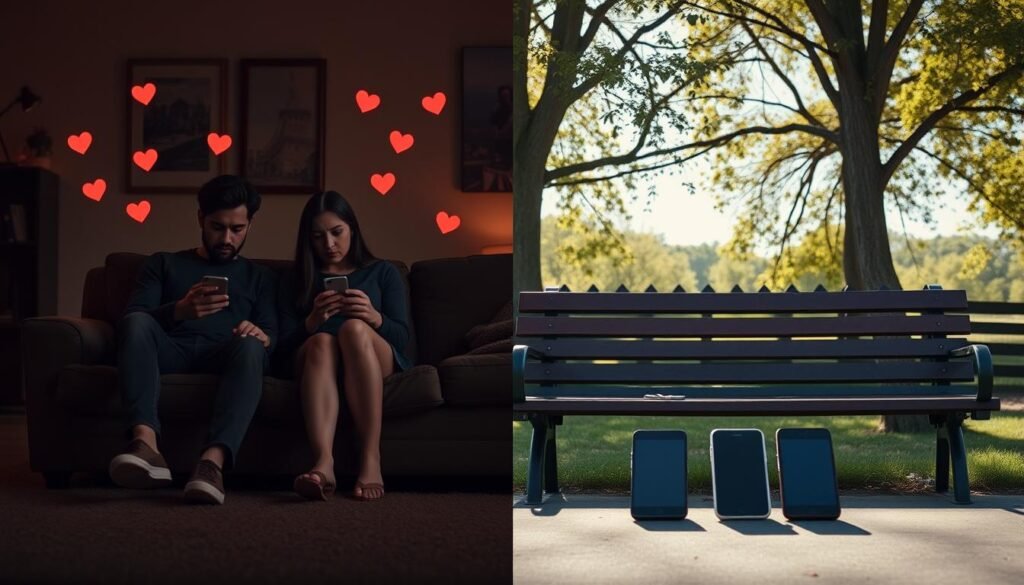Did you know that a stunning one-fifth of Americans link their tech use to major stress? In the digital era, texting anxiety is a big problem for people. They struggle with communication through their screens. This issue comes from the fear of texting and stress from messages. This is because texts lack nonverbal cues. It’s important to know the signs and causes of texting anxiety. This helps in building healthy communication habits.
This piece explores the signs, core reasons, and ways to handle texting anxiety. It offers tips to help people take charge of their digital talks. To tackle text message anxiety, understanding it is key. This empowers individuals to chat confidently in our digital age.
Key Takeaways
- Texting anxiety affects many, especially the young.
- It shows through physical and emotional signs like a higher heart rate and discomfort.
- Negative past experiences and social media pressure are common causes.
- Setting limits on phone use can ease texting stress.
- Talking face-to-face is often clearer than texting.
Understanding Texting Anxiety
Texting anxiety is the stress one feels about messaging on smartphones. It’s not officially recognized as a clinical issue, but it affects many. People with this anxiety may have a racing heartbeat or feel sick when texting. The rise of smartphone use has increased texting anxiety. Now, billions of messages are sent in the U.S. every year. This makes texting a key way people talk to each other.
Definition and Overview
Texting anxiety includes fearing no reply or misunderstanding texts. It can come from past events, social stress, or how fast we talk online. Smartphones keep us connected all the time, making some feel they must always reply. Knowing these feelings is important as we deal with daily chats.
Prevalence in Modern Communication
Texting anxiety has grown with more people texting, especially during COVID-19. A 26% jump shows more prefer texting now. With more texting comes more anxiety about it. A 2020 survey saw a 77% rise in multimedia messages. This highlights how common texting stress is.
Signs of Texting Anxiety
Texting anxiety shows both physical and emotional signs. Many people feel various symptoms when texting. Recognizing these signs helps understand texting’s effects on health.
Physical Symptoms
Texting anxiety’s physical signs include:
- Increased heart rate
- Sweaty palms
- Shallow breathing
- Muscle tension
- Nausea or a feeling of unease
These symptoms point to the fear tied to texting. The constant need to check phones and reply fast causes stress.
Emotional and Behavioral Signs
Emotionally, texting anxiety causes:
- Overthinking message content
- Procrastination in replying due to fear of misinterpretation
- Feelings of overwhelm upon receiving notifications
Worry over how texts are understood can lead to stress. Especially for those who already feel social anxiety. Learning to manage these feelings is key for good communication.
Common Causes of Texting Anxiety
Getting to the bottom of texting anxiety is key. It can come from bad past events, social media’s effects, or mental health issues. Knowing these reasons helps us understand our fear of texting better.
Previous Negative Experiences
Many feel nervous about texting because of previous problems. For example, if texts like “K” seemed cold, it can make future texting scary. These mishaps can make someone want to avoid texting altogether.
Influence of Social Media on Communication
Social media changes how we talk to each other, making texting more stressful. With no face-to-face clues, it’s easy to take things the wrong way. A message like “Can we talk?” can suddenly feel alarming. The fast-paced nature of online chats can make this stress worse.
Underlying Mental Health Issues
Mental health issues also lead to texting anxiety. For those with social anxiety or who are perfectionists, texting feels especially hard. Worrying about saying the right thing or being judged adds to the stress. Experts say using friendly, clear ways of texting can help, but it’s often not that simple.

The Impact of Texting Anxiety on Relationships
Texting anxiety can significantly affect personal relationships. This leads to misunderstandings and communication challenges. It impacts romantic relationships, friendships, and family connections differently.
Effects on Romantic Relationships
In romantic contexts, texting anxiety often becomes stronger at the beginning. Partners might second-guess their texts or worry about their words’ impact. This worry can increase tension over phone messages.
The challenge in expressing tone and emotion through text often causes misunderstandings. These issues could be avoided with in-person conversations, creating clearer understanding between partners.
Impacts on Friendships and Family Dynamics
Texting anxiety affects friendships and family interactions too. People may withdraw from conversations, fearing misunderstandings or slow replies. This withdrawal can lead to emotional distance and more anxiety.
With social media and digital communication’s rise, connecting feels overwhelming at times. This can strain important relationships. People might choose their mental health over constant digital engagement.

Messaging App Culture and Its Role in Texting Anxiety
Messaging apps have changed how we talk to each other. Now, people feel stressed due to the expectation that they must reply fast. This leads to messaging apprehension because users hurry to answer all alerts.
The Shift to Instant Communication
Now, instant messaging is common both at work and at home. About 71% of people quickly reply to messages. This impacts their balance between work and life, increasing texting anxiety. Larry D. Rosen, a psychologist, notes waiting for responses can raise stress. Many are glued to their phones, interrupting work to not miss anything. This fear of missing out adds to their anxiety.
The Pressure of Immediate Replies
The need for quick replies can cause SMS panic if we don’t answer fast. This urgent culture makes every notification stressful. To lessen this stress, users should tell others when they are busy. Setting clear limits and specific times to check messages can help. By doing these things, we can change how society sees texting and feel less pressure to always be on.
| Behavior | Effect on Texting Anxiety |
|---|---|
| Checking notifications every 30 minutes | Reduces anxiety linked to responsiveness |
| Disabling notifications | Minimizes distractions and stress |
| Using voice calls | Enhances emotional connection and empathy |
| Informing others of unavailability | Alleviates pressure to respond instantly |

It’s key to find a balance in how we communicate. Accepting response delays can help ease the rush created by digital messages. By doing so, we reduce texting anxiety and foster healthier conversations. To learn more about managing this stress, check out these helpful tips. Knowing the effects of messaging on our anxiety can lead to better interactions.
Texting Anxiety in Younger Generations
Today, young people are deeply influenced by their smartphones and social media. Texting anxiety is a big issue for them. It’s closely connected to their digital habits, like worrying about phone messages. Studies show that Gen Z faces challenges unique to their online lives.
Statistics on Smartphone Usage
Teenagers’ smartphone usage has soared in recent years. By 2022, nearly 95% of them were on social media. A study showed about 22% of 10th-grade girls spend over seven hours daily on social platforms. This leads to more texting stress and anxiety.
The Role of Dating Apps and Online Interaction
Dating apps add challenges to online lives of young people. These apps can help form connections but often raise anxiety levels. Young adults worry about the need to reply fast, which adds to their texting anxiety. Social media and dating apps can make loneliness worse, even though they’re meant to connect us.
For more insights on the impact of social media on anxiety, visit here.
Coping Strategies for Texting Anxiety
Managing texting anxiety means adopting coping strategies that better your emotional health and communication. Navigating anxious texting requires a proactive and mindful approach. Here are some effective ways to reduce texting stress.
Think Before You Type
Taking a moment to think before sending a text can reduce quick, thoughtless replies. This helps avoid misunderstandings and prevents situations from getting worse due to texting anxiety. By considering the tone and content of your message, you can share your thoughts more clearly and confidently.
Practice Mindfulness and Grounding Techniques
Mindfulness techniques can greatly ease texting-related anxiety. Grounding exercises or focused breathing can help you stay calm in stressful moments. These methods not only relax you but also help you handle the emotions that come with anxious texting.
Set Boundaries Around Phone Use
Setting rules for when and how much you use your phone can help manage texting stress. You might limit how often you check your messages or create phone-free times during meaningful interactions. This can lead to better communication habits and more fulfilling relationships, lessening texting anxiety.
By recognizing your anxious texting habits and using these strategies, you can manage your texting stress. Self-assessment helps in tackling and prioritizing mental health, as seen in resources like the anxiety quiz. Understanding your anxiety is a step towards finding better coping mechanisms and improving how you communicate.
The Benefits of Face-to-Face Communication
Meeting someone face-to-face has many upsides that reduce the stress of texting. This is very real in our online world. Non-verbal signs like body language and the tone of voice give depth to chats. These are missing in texts. They help lessen the dread of texting and create deeper emotional links.
Importance of Non-Verbal Cues
Talking in person lowers the chances of misunderstanding common in texts. It also leads to true engagement. During the COVID-19 lockdown, studies found face-to-face chats greatly improved mental health. This was more effective than texting. People felt less alone and happier with direct conversations. It shows being together matters a lot for feeling good and fighting text anxiety.
Building Emotional Connections Without Texting
Additionally, talking directly lets people form stronger emotional connections. This is something hard to get through digital messages. Research shows that relying too much on texting can make people more anxious. It can also make controlling emotions harder. By choosing to meet in person more, we can reduce the stress from texting. This leads to healthier friendships and makes us feel better about our social lives.